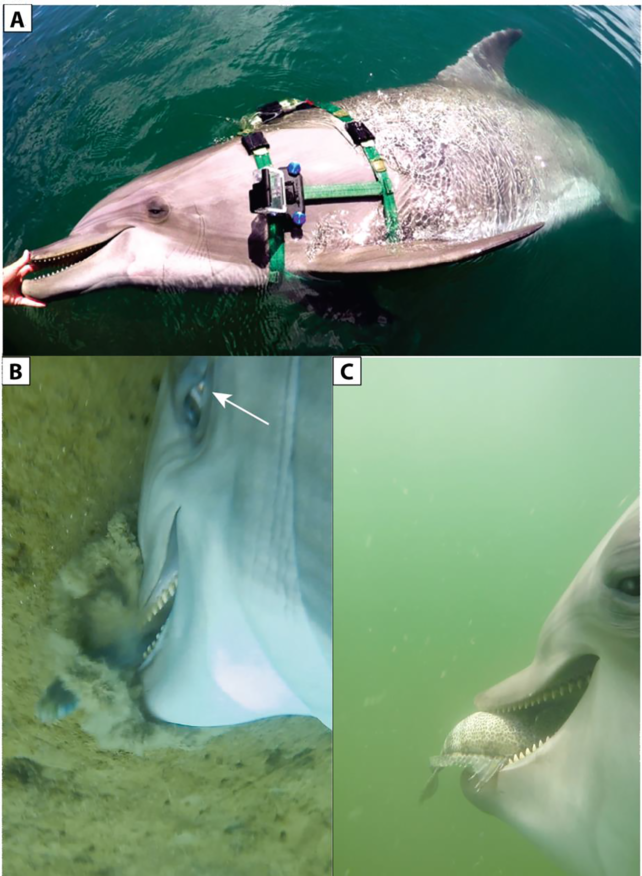A buzz of clicks and joyful cries of victory provide the soundtrack to the first footage ever recorded from the perspective of dolphins hunting freely off the coast of North America.
For a scientific study published in 2022, the US Navy strapped cameras to dolphins, which are trained to help identify undersea mines and protect part of the US nuclear stockpile, and then gave them free rein to hunt in San Diego Bay.
The clever marine mammals did not disappoint, providing exciting chases and, to the researchers’ surprise, even targeting venomous sea snakes.
For such popular, well-known animals, there are still so many fundamental things we don’t yet know about these highly social and often coarse cetaceans, such as how they typically feed.
Researchers roughly know of at least two techniques: slurping prey like noodles from a bowl and ramming them like a hot dog between rides at a state fair.
But the images revealed much more.
The cameras, strapped to six bottlenose dolphins (Tursiops truncatus) from the US National Marine Mammal Foundation (NMMF), recorded six months of footage and audio, giving us a new level of insight into these mammals’ hunting strategies and communication.
The recording equipment was placed on their backs or sides, revealing the disturbingly strange angles of their eyes and mouths.
Although these dolphins are not wild, they are regularly given the opportunity to hunt in the open ocean, supplementing their usual diet of frozen fish. So it’s likely that these animals use similar methods to their wild brethren, as NMMF veterinarian Sam Ridgway and colleagues explained in 2022.
“While dolphins hunted, they clicked almost constantly at intervals of 20 to 50 milliseconds,” they report in their paper.
“When approaching prey, the click intervals shorten to a terminal buzz and then a beep. When in contact with fish, the buzz and beep was almost constant until after the fish was swallowed.”
frameborder=0″ allow=accelerometer; autoplay; clipboard writing; encrypted media; gyroscope; picture-in-picture; web-share” referrerpolicy=”strict-origin-when-cross-origin” allowfullscreen>
The camera-strapped dolphins caught more than 200 fish, including bass, dolphins, halibut, smelt and pipefish. The smoke often threw itself into the air in desperate attempts to escape the skilled predators.
But the dolphins followed their every move and swam upside down to give their rotating eyes a clear view – a technique previously seen in wild dolphins.
“These dolphins appeared to use both vision and sound to find prey,” Ridgway and colleagues explained. “At a distance, the dolphins always used echolocation to find fish. At close range, vision and echolocation seemed to be used together.”
The cameras also recorded the sounds of the animals’ hearts as they pumped hard to keep up with the strenuous activities, revealing that instead of ramming their victims down, the dolphins instead used suction to suck down their still-struggling prey swallowing with an impressively strong throat. muscles.
The dolphins usually sucked in fish from the sides of their open mouths, expanding the throat muscles and pulling the tongue out of the way. The extensive inner mouth space helps create negative pressure that their sucking muscles contribute to.

Although dolphins have been caught playing with snakes before, including river dolphins playing with an absurdly large anaconda, the footage confirmed for the first time that they may also be eating these reptiles.
One dolphin ate eight highly venomous yellow-bellied sea snakes (Hydrophis platurus).
“Our dolphin showed no signs of illness after eating the small snakes,” the researchers explained, but they acknowledged that this could also be unusual behavior since the dolphins are captive animals.
“Perhaps the dolphin’s lack of experience feeding on dolphin pods in the wild led to the consumption of this outlier prey.”
The study’s lead author, Sam Ridgway, died at the age of 86, shortly before the study was published, leaving behind a rich legacy of research.
“His creative approach to working with marine dolphins to better understand the species’ behavior, anatomy, health, sonar and communication will continue to educate and inspire future scientists for generations,” NMMF ethologist Brittany Jones said. The Guardian.
The Navy-trained dolphins work “in open water almost every day,” NMMF explains on their website.
“They can swim away if they want to, and there have been a few over the years. But almost all of them stay.’
This research was published in PLOS ONE.
An earlier version of this article appeared in August 2022.



